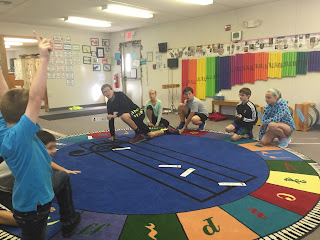Relay Races are a great way to get kids up and moving to review ANY musical subject.
I do relay races to review rhythms, solfege, vocabulary, lines and spaces on the staff and more.
Not only do gets get up and moving in a relay race, but it is a great way to secretly individually assess students while they are having fun.
For ANY type of relay race it is always fun to have the students race in different ways- Mine love to bear crawl, crab walk, tip toe, skip and more.
Here are some of the relay races I have done recently:
Staff Relay Races: Students use cups (or plates) to spell words on our large floor staff. If you do not have a large floor staff, just make on with tape! I say a word and the first person on the relay team places the cup on the first letter of the word, then races back to their team and second person moves the cup to the second letter and so on. My 6th graders had so much fun with this!
Rhythm (or solfege) Relay Races: These can be done in a few ways-
Have rhythm cards at the end of the room across from each team. Teacher reads a card, and then the students race to find the correct card then back to their team. Then the teacher reads another. 2nd level of this version would be teacher reads a succession of cards and the 1st student in line finds the first card, 2nd in line finds the 2nd card, etc. Don't want to make all the rhythm cards? Check out this set from Lindsay's Kodaly Inspired Classroom on TPT:
Wild Rhythm Races Bundled Set She has other sets for various seasons too- so fun! She has her students use scooters to race to the rhythms and back! In the picture below you can see my kids ready to ride, and in the corner is one groups rhythm cards all mixed up. I said a rhythm and they had to race down and find it.
You could also have students race to a sight-reading page and have to read examples from the page. The first group to complete the page wins.
In addition to the racing, sometimes it is fun to have the students complete another task before they can race back to their team for the next person to go. I saw on facebook last week that a teacher had her class do bottle flipping relays. Once they got the bottle to stand up they raced to a sight-reading page and read an example then raced back to their team. This idea is so great because so many students get in trouble for bottle flipping anyways- we might as well turn it into something productive. :)
Also- while it is not really a relay race persay, My students love Rhythm Football. A student from each team races to get the rhythm (or solfa) card called to their endzone first. Check out more about this game
HERE and you can get the rhythm card sets
HERE.
Side note: If you aren't in the Elementary Music Teachers group on facebook- you should be. Other great groups are Kodaly Educators, and I'm a General Music Teacher. Check them out!
Vocab Relay Races: For Vocab relay races in my room students have to build a 3-tier vocab tower. Word, Symbol, and Definition. I give a word or show a symbol and then they have to find the correct tower pieces in a pile at the other end of the room. The towers to not have to be built in any specific order, so the first student can pull ANY of the 3 pieces from their pile, the 2nd only has two left and the 3rd student has the hardest job of figuring out what piece of the tower is missing. For these I use my Vocab Stacking Sets on TPT. There is a
Spring Set which I will be using soon as well as a snowman set, a jack-o-lantern set, a heart set and a back-2-school set. Check them all out
HERE
Fly Swatter Game: Each of these games also has the symbols printed on LARGE pieces so you can play the fly swatter game with your classes.
For the fly-swatter game, you post one set of pictures on the board and then students in different teams race to swat the correct word or symbol first. Sometimes I say the word, sometimes I say the definition, and they have to swat the symbol. SO FUN!
There are also instruments of the orchestra versions of all of these games in my TPT store- the same races would work really well! Check those out
HERE
Have you done relay races in your room?














